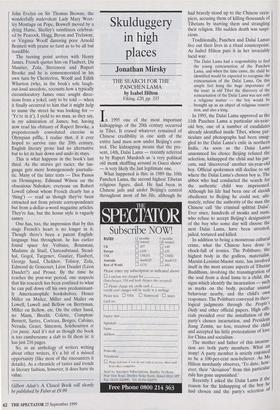Skulduggery in high places
Jonathan Mirsky
THE SEARCH FOR THE PANCHEN LAMA by Isabel Hilton Viking, £20, pp. 335 In 1995 one of the most important kidnappings of the 20th century occurred in Tibet. It erased whatever remained of Chinese credibility in one sixth of the entire land mass now under Beijing's con- trol. The kidnapping means that the pre- sent, 14th, Dalai Lama — recently referred to. by Rupert Murdoch as 'a very political old monk shuffling around in Gucci shoes' — is very likely the last legitimate one.
What happened is this: in 1989 the 10th Panchen Lama, the second highest Tibetan religious figure, died. He had been in Chinese jails and under Beijing's control throughout most of his life, although he had bravely stood up to the Chinese occu- piers, accusing them of killing thousands of Tibetans by starving them and strangling their religion. His sudden death was suspi- cious.
Traditionally, Panchen and Dalai Lamas live out their lives in a ritual counterpoint. As Isabel Hilton puts it in her invariably lucid way:
The Dalai Lama had a responsibility to find the young reincarnation of the Panchen Lama, and when the time came, the child he identified would be expected to recognise the reincarnation of the Dalai Lama. On this simple fact hung the huge importance of the issue: in old Tibet the discovery of the reincarnation of the Dalai Lama was not only a religious matter — the boy would be brought up as an object of religious venera- tion, and also a king.
In 1995, the Dalai Lama approved as the 11th Panchen Lama a particular six-year- old boy, one of a number of candidates already identified inside Tibet, whose par- ticulars and photographs had been smug- gled to the Dalai Lama's exile in northern India. As soon as the Dalai Lama announced his choice Beijing refused the selection, kidnapped the child and his par- ents, and 'discovered' another six-year-old boy. Official spokesmen still decline to say where the Dalai Lama's chosen boy is. The abbot who had conducted the search for the authentic child was imprisoned. Although his life had been one of slavish obedience to Beijing he could not, ulti- mately, refuse the authority of the man the Chinese call 'the criminal splittist Dalai'. Ever since, hundreds of monks and nuns, who refuse to accept Beijing's designation of the boy who some day will choose the next Dalai Lama, have been arrested, jailed, tortured and killed. In addition to being a monstrous cultural crime, what the Chinese have done is chock-full of ironies. The Politburo, the highest body in the godless, materialist, Marxist-Leninist-Maoist state, has involved itself in the most arcane aspects of Tibetan Buddhism, involving the transmigration of the soul from a dead lama to a child, the signs which identify the incarnation — such as marks on the body, peculiar animal behaviour nearby, and the child's own responses. The Politburo conveyed its theo- logical judgments through the People's Daily and other official papers. High offi- cials presided over the installation of the party's chosen incarnation, and President Jiang Zemin, no less, received the child and accepted his little protestations of love for China and socialism.
The mother and father of this incarna- tion are both party members. What an irony! A party member is strictly enjoined to be a 100-per-cent non-believer. As Ms Hilton mordantly observes, 'To date, how- ever, their "deviation" from this particular rule has gone unpunished.' Recently I asked the Dalai Lama if the reason for the kidnapping of the boy he had chosen and the party's selection of another boy was to guarantee that after he dies Beijing will control the choice of the 15th Dalai Lama. He agreed. He noted, however, that either he is the last Dalai Lama or that the next one will be found outside Beijing's control.
Isabel Hilton, one of Britain's few home- grown top-grade China specialists and once the China correspondent of the Sunday Times, has been very near the centre of this depressing but fantastic adventure story and intrigue. She tells the tale wonderfully, often very comically, and she is always thoroughly informed. If you want a crash course in Tibetan history and affairs in addition to a rattling good story, this is the book.
Ms Hilton was asked by the Dalai Lama to follow the course of this contest between himself and Beijing for the year up to the kidnapping of the authentic Panchen Lama and the installation of the bogus one. She was the discreet repository of his confi- dences, his doubts and his indiscretions. He admitted to her that by revealing his choice as publicly as he did, 'I committed a crime here and they took the punishment there.'
In the course of this extraordinary responsibility, she travelled not only to the Dalai Lama's Indian enclave but to Beijing, where she met the 10th Panchen's belea- guered wife and daughter, to Lhasa, where she took great risks meeting knowledgeable Tibetans, and to other Tibetan towns, in one of which she found the,10th Panchen's illiterate, frightened mother. What Isabel Hilton has done, weaving her way through a series of scoops about far-off kidnapping and child-switching, any one of which would make a journalist's career, is to make clear that 'in the contest for the hearts and minds of Tibet, Communist doctrine was running Buddhism a poor second'.



























































































 Previous page
Previous page